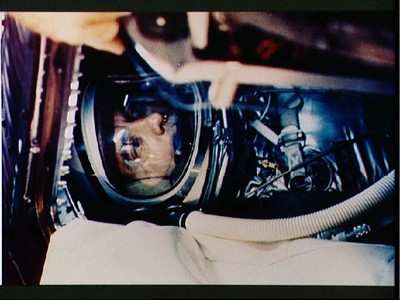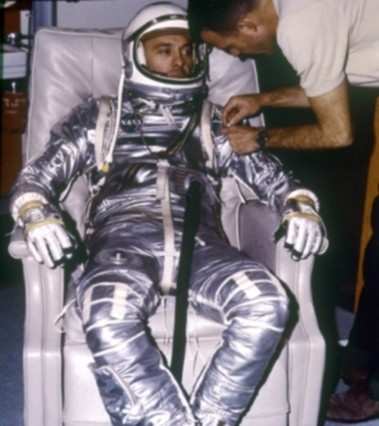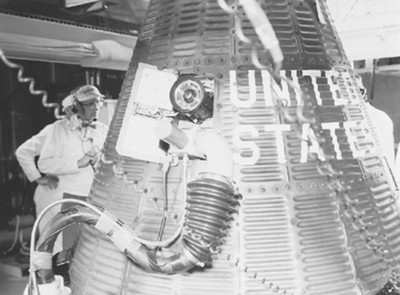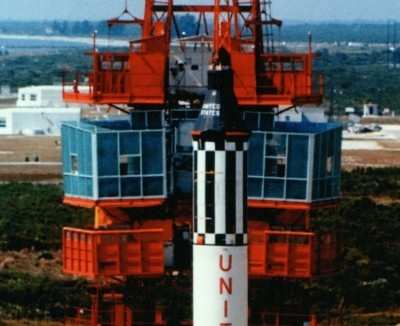Some Things You May Not Know About The History Made 50 Years
Ago
Special To ANN By Wes Oleszewski
On May 5th, 1961 the United States launched its first astronaut.
Flying aboard his Mercury capsule, Christened "Freedom 7," Alan
Shepard made a sub-orbital hop down the Atlantic Missile Range. His
flight lasted just 15 minutes and 28 seconds and brought the free
world to a standing ovation. Since then a number of myths and
legends have grown around the event. From a Hollywood movie that
played VERY loosely with the facts, to poorly produced
documentaries, to sanitized accounts published by NASA and "Life
Magazine," to personal accounts drafted from memories with plenty
of wear on them- it is often hard to drum out something close to
the truth. In light of the recent passing of the 50th anniversary
of Freedom 7, I figured it would be fun to denote a few of the odds
and ends of the mission here.

Shepard Aboard Freedom 7
One commonly held myth is that Shepard reported aspects of his
condition and that of his capsule as being "A-OK." In fact, Shepard
never used the term "A-OK" during the mission. The term "A-OK" was
actually coined by NASA Public Affairs Officer (PAO) John "Shorty"
Powers who announced the flight.
Many people think that during Shepard's flight, the public heard
his voice calling out readings and making observations. In fact not
a single word that Shepard spoke during the mission was allowed to
be heard live by the public. Only those who were working the
mission and had a "need-to-know" were allowed to hear the live
air-to-ground transmissions. This may seem amazing today where
nearly every word of a spaceflight is broadcast live. Although NASA
was far less risk averse in the Mercury days, they were far more
image aware. All of the air-to-ground that the Mercury astronauts
broadcast was filtered through PAO Shorty Powers who then repeated
to the public a "NASA-correct" version of what was being said.
Shortly after the flight, films of the mission had the edited voice
track of the astronaut dubbed in and from there on that became the
"official version" of the mission. As the Gemini program came into
being, the voices of the crew on orbit were allowed to be
broadcast, but were done so on a NASA time delay. Reentry and
launch air-to-ground was not allowed to be heard live by the public
until Apollo 10 (believe it or not).

Alan Shepard Suiting Up
Exactly who would be the astronaut to fly aboard the first
Mercury spacecraft was kept a close secret within NASA. All that
was released to the public were the names of the top three choices;
Glenn, Grissom and Shepard. It was not until after the scrub of
Shepard's original launch date of May, 2nd that NASA decided to
actually make public his identity as the first United States
astronaut. There were very elevated concerns that if the Soviets
found out which of the Mercury 7 astronauts was slated to make the
first flight, they may assign agents to do harm to that individual.
Historians digging in the KGB archives have found no such
inclination by the Soviets, however.
In that near-fictional movie "The Right Stuff" Sheppard is shown
stepping from the transfer van at the launch pad, stopping and
looking up at the booster and giving a big "Thumbs Up." He did stop
and look the booster over, but he never did the thumbs-up.
Additionally, the movie shows him stepping from the recovery
helicopter onto the carrier deck and having his first footprints on
the deck outlined in yellow paint. That never happened either. Of
course those are just two of about a bazillion errors in that
movie.

Freedom 7 Periscope
Shepard's Freedom 7 was the only manned Mercury spacecraft that
did not have a "pilot's" window. Instead the spacecraft had two
portholes located approximately where the astronaut's elbows would
be. It was nearly impossible for a pressure-suited astronaut with a
helmet on to see anything through the portholes. Like all manned
Mercury spacecraft, however, Shepard's had a periscope. The
periscope was a handy tool and the Mercury crews liked it. As
Shepard waited through a series of pre-launch holds he had nothing
to do other than look out through the periscope. At sunrise, as the
vehicle sat on the pad, the sun shied directly into the periscope
and Shepard put in a gray filter to cut down the glare.
Unfortunately, prior to launch he remembered to retract the
periscope, but forgot to remove the dark gray filter. During his
flight, there was a specified point where he was supposed to look
through the periscope and make a report. Dutifully, he deployed the
periscope and discovered that the dark filter heavily obscured what
he could see. When he reached to remove the filter he found that
his gloved hand was bumping against the "Abort" handle. So he
wisely decided to just leave the filter in. "I really couldn't see
a damned thing through it." he confided to Grissom after the
flight, "So I just gave the same weather report that I'd been given
in the preflight briefing and called out some known landmarks." In
fact, if you read the actual weather briefing given to Shepard
before the launch and compare it to what he broadcast back to the
ground it is almost word-for-word the same… with a few well
known landmarks thrown in.
The service gantry used on Shepard's Mercury Redstone was a
former oil derrick that was disassembled and trucked to Cape
Canaveral in the early 1950s. It was set up at the newly
established Launch Complex 3 & 4 to service the Army's first
Redstone tests. The first of those launches took place on August
20, 1953 and the gantry was moved on common railroad rails in order
to clear the rocket. Sometime between March of 1955 and April 1955
the tower was lowered and the gantry was moved by rails to the
Army's new Vertical Launch Facility. It was there that the gantry
serviced Freedom 7's launch vehicle.

"Surfside 5"
Shepard's launch gantry also had a special enclosure constructed
on it that would surround the Mercury spacecraft and keep out the
rain, sun plus most of the sand and dust. The enclosure was air
conditioned by a 10 ton machine and today would be called a "White
Room." In 1961, however, there was a TV show that was set in Miami
and was called "Surfside 6" so the folks at the pad decided to call
their white room "Surfside 5."
Once the service gantry was rolled away, a yellow truck with a
"cherry picker" basket was parked nearby. The basket was raised up
alongside the spacecraft and parked near the hatch. This was
supposed to serve as "quick escape" device for Shepard. There was
only one problem. The hatch that the basket was parked next to was
sealed with 70 (Yes… SEVENTY) bolts each or which had to be
removed with a wrench, individually, by hand, from the outside. You
see these were not the "explosive bolts" used on later Mercury
spacecraft- these were good old-fashioned twist 'em in with a
wrench by hand bolts. They made the cherry picker parked next to
Shepard's spacecraft absolutely useless. In an on the pad emergency
that would require Shepard to quickly evacuate his spacecraft there
was simply no way for him to get himself out from the inside. The
other route of egress was by way of a forward opening. This was
used after splashdown and was actually the way that Shepard got out
following the flight. It involved the use of a plug hatch in the
forward end of the capsule. The astronaut removed his helmet and
contorted himself around to squeeze past the instrument panel and
out the top of the spacecraft. As the vehicle sat on the pad,
however, this hatch had the entire launch escape tower and main
parachutes on top of it and thus was also useless for escape. So,
the big yellow cherry-picker was nothing more than window-dressing
as far as Freedom 7 was concerned.

Cherry Picker "Escape" System
So, although the flight of Freedom 7 was a historic event that
was planned to the smallest detail, there were still some odd
aspects to it. The legends and myths about the flight grew on their
own plus a little help by TV and movie producers who know and care
nothing about spaceflight.
Although Soviet leader Nikita Khrushchev called the flight of
Freedom 7 "A flea's jump," Shepard's flight was 100% successful. To
many Americans it was a grand-slam home run scored in a game of
spaceflight with the Soviets were we had previously been hitting
foul balls and striking out. The flight helped influence President
Kennedy to set the nation's course toward a landing on the moon.
Additionally, in the wake of the Bay of Pigs political disaster,
the Freedom 7 mission was the first major positive political event
in the Kennedy administration. Overall, May 5th, 1961 was a very
good day in the free world… the oddities, myths and legends
aside.
 ANN's Daily Aero-Linx (04.13.24)
ANN's Daily Aero-Linx (04.13.24) ANN's Daily Aero-Term (04.13.24): Beyond Visual Line Of Sight (BVLOS)
ANN's Daily Aero-Term (04.13.24): Beyond Visual Line Of Sight (BVLOS) Airborne 04.09.24: SnF24!, Piper-DeltaHawk!, Fisher Update, Junkers
Airborne 04.09.24: SnF24!, Piper-DeltaHawk!, Fisher Update, Junkers Aero-News: Quote of the Day (04.14.24)
Aero-News: Quote of the Day (04.14.24) ANN's Daily Aero-Term (04.14.24): Maximum Authorized Altitude
ANN's Daily Aero-Term (04.14.24): Maximum Authorized Altitude







